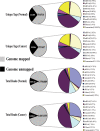MicroRNA Expression Profile in Penile Cancer Revealed by Next-Generation Small RNA Sequencing
- PMID: 26158897
- PMCID: PMC4497725
- DOI: 10.1371/journal.pone.0131336
MicroRNA Expression Profile in Penile Cancer Revealed by Next-Generation Small RNA Sequencing
Abstract
Penile cancer (PeCa) is a relatively rare tumor entity but possesses higher morbidity and mortality rates especially in developing countries. To date, the concrete pathogenic signaling pathways and core machineries involved in tumorigenesis and progression of PeCa remain to be elucidated. Several studies suggested miRNAs, which modulate gene expression at posttranscriptional level, were frequently mis-regulated and aberrantly expressed in human cancers. However, the miRNA profile in human PeCa has not been reported before. In this present study, the miRNA profile was obtained from 10 fresh penile cancerous tissues and matched adjacent non-cancerous tissues via next-generation sequencing. As a result, a total of 751 and 806 annotated miRNAs were identified in normal and cancerous penile tissues, respectively. Among which, 56 miRNAs with significantly different expression levels between paired tissues were identified. Subsequently, several annotated miRNAs were selected randomly and validated using quantitative real-time PCR. Compared with the previous publications regarding to the altered miRNAs expression in various cancers and especially genitourinary (prostate, bladder, kidney, testis) cancers, the most majority of deregulated miRNAs showed the similar expression pattern in penile cancer. Moreover, the bioinformatics analyses suggested that the putative target genes of differentially expressed miRNAs between cancerous and matched normal penile tissues were tightly associated with cell junction, proliferation, growth as well as genomic instability and so on, by modulating Wnt, MAPK, p53, PI3K-Akt, Notch and TGF-β signaling pathways, which were all well-established to participate in cancer initiation and progression. Our work presents a global view of the differentially expressed miRNAs and potentially regulatory networks of their target genes for clarifying the pathogenic transformation of normal penis to PeCa, which research resource also provides new insights into future investigations aimed to explore the in-depth mechanisms of miRNAs and other small RNAs including piRNAs in penile carcinogenesis regulation and effective target-specific theragnosis.
Conflict of interest statement
Figures


References
-
- Misra S, Chaturvedi A, Misra NC. Penile carcinoma: A challenge for the developing world. Lancet Oncol. 2004; 5: 240–247. - PubMed
Publication types
MeSH terms
Substances
LinkOut - more resources
Full Text Sources
Other Literature Sources
Research Materials
Miscellaneous

